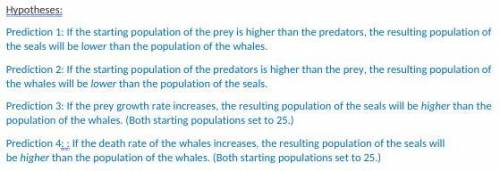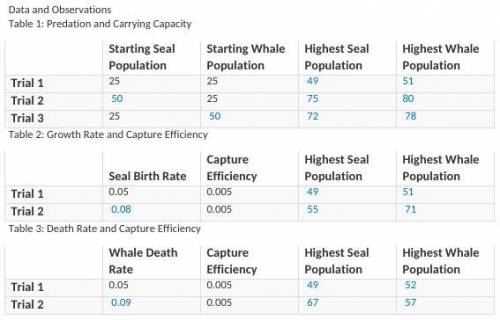Analysis and Conclusion:

Will give brainliest to the best answer.
(see pics for info)
Analysis and Conclusion:
Be sure to answer the following reflection questions as a summary paragraph in the conclusion of your lab report:
Were your hypotheses correct or incorrect? Why or why not?
Which factors affecting population growth and decline are modeled with the graphs?
Using Table 1, which of the three trials produced the highest population for both the whales and the seals? Why do you think this trial had the best outcome for the whale and seal populations?
Using Table 2 and 3, explain how the birth rates of the seals and the death rates of the whales affected the population for both whales and seals.
Questions:
(Using what you have learned from the lesson and the virtual lab activity, answer the following questions in complete sentences:)
1) Describe three additional biotic and abiotic factors not modeled in the simulation that could affect the population dynamic of the whales and seals.
2) Explain why some limiting factors may lead to drastic changes in whale and seal populations, while others may only cause minimal changes.
3) In this lesson, you learned about two patterns of population growth and decline, the sigmoid and peak phenomena. Does the seal and killer whale relationship represent a sigmoid or peak phenomenon? Please provide supporting details.
4) A microbe from an ecosystem that exists in the same arctic region has infected the whale population. The graph below shows the new carrying capacity for the whale population.
5) [see the graph pic] N is a steady horizontal line, slopes down, then levels off with N. N rises over time, sharply declines, rises again slightly, then levels off with K. N represents population number, t represents time, and K represents carrying capacity.
6) Explain how these microbes have affected the whale population. Does this new evidence change the seal and killer whale relationship? Does this new relationship represent a sigmoid or peak phenomenon? Please provide supporting details.
7) If scientists added a chemical to destroy the arctic microbes, what positive and negative consequences could result? What population settings could you adjust in the simulation to test components of this solution?
8) Climate change in the form of global warming (an abiotic factor) has slowly decreased habitat for the arctic seals. What are the limitations of the population dynamics simulation in predicting the changes that may occur due to climate change?
9) Imagine that all nations agreed to reduce greenhouse gas emissions by half in an effort to reduce global warming. In what ways could you revise this simulation, so it accounted for the influence of this solution on arctic habitat, and on the whale and seal populations?




Answers: 3
Other questions on the subject: Biology


Biology, 22.06.2019 07:50, darceline1574
Which of the following types of stars is most likely to end up as a supernova? in graph a, the curve peaks at 800 nm, in the red section of the visible light spectrum. in graph b, the curve peaks at 550 nm, in the green section of the visible light spectrum. in graph c, the curve peaks at 450 nm, in the blue section of the visible light spectrum. in graph d, the curve peaks at 300 nm, in the violet section of the visible light spectrum. a b c d
Answers: 2

Biology, 22.06.2019 09:40, kenldykido2300
Me brainliest 1. what does a red shift mean? blue shift? 2. describe the big bang theory. according to this theory, how old is the universe? 3. scientists believe the universe is expanding. what is the evidence that supports this? 4. describe a nebula.5. describe the 3 types of galaxies. what is a barred spiral galaxy? 6. what is a light year? how far is alpha centauri from earth? 7. describe the universal law of gravitation. be sure to include gravitational force between two objects.8. describe the planets’ orbits around the sun.9. what is the asteroid belt? where is it located? 10. describe rotation and revolution of earth. what determines an earth day and year? 11. how do galaxies exist? 12. compare and contrast the inner and outer planets.13. what causes the seasons?
Answers: 1

Biology, 22.06.2019 18:20, marcaveli294
Astudent measured the amount of carbon dioxide (co2) produced by yeast during an experiment. use the data in the table at the right to answer the questions below. which variable is the dependent variable?
Answers: 3
Do you know the correct answer?
Will give brainliest to the best answer.
(see pics for info)
Analysis and Conclusion:
Analysis and Conclusion:
Questions in other subjects:



Mathematics, 18.01.2021 22:40

Mathematics, 18.01.2021 22:40

Mathematics, 18.01.2021 22:40


Physics, 18.01.2021 22:40


Social Studies, 18.01.2021 22:40

Mathematics, 18.01.2021 22:40






